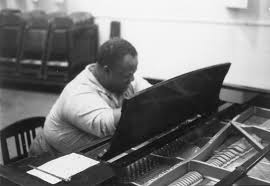Blues part 3 – Meade Lux Lewis
The third in a series of five solo explorations of the blues, recorded at the very first Blue Note Records session. Our transcription is very detailed with all important dynamic and articulation markings.
- Recording: Albert Ammons - Meade Lux Lewis - The First Day
- Recorded on: January 6, 1939
- Label: Blue Note (7-98450-2)
- Concert Key: C
- Vocal Range: , to
- Style: Swing (slow)
- Piano - Meade Lux Lewis
Video
- Description
- Historical Notes
- Solos
- Piano Corner
- Bass Corner
- Drum Corner
- Guitar Corner
- Inside & Beyond
- Minus You
This solo has a lot of dynamic contrast throughout, especially in the third chorus. Note also the dynamics in the fifth chorus: the first two triplets in each measure are relatively soft and contrast with the accented, repeated triplets in the rest of the measure.
The harmonies in the second chorus are very similar to those in the second chorus of part 2, with the diminished passing chord; the left hand voicings are an octave lower. The fifth chorus has the same open position voicings in the left hand as in the sixth chorus of part 1; all these solos except part 5 have at least some of these left hand voicings in the second to last chorus. The descending chordal sequence common to most of these solos appears here in the ninth measure of both the fourth and fifth choruses.
"The First Day."
These solos are played with a rolling swing feel, and we have notated swing eighth notes in triplets in many places where the rhythmic feel is dominated by triplets.
Related Songs
Email Send Blues part 3 to a friend

Meade Lux Lewis
September 4, 1905 – June 7, 1964
Born Meade Anderson Lewis in Chicago, Meade "Lux" Lewis is one of the most important early jazz pianists. When he was a child, his father insisted that Meade learn violin. After his father died, he took up piano at the age of 16. He learned by listening to pianist Jimmy Yancey and received no training. Despite this, his considerable skill earned him the attention of the Chicago music scene, and in addition to securing local gigs, he made his recording debut in 1927 with "Honky Tonk Train Blues" for Paramount Records. Read more...

